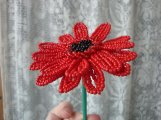Sections:Technology, Primary School
Introduction
The flowers have always attracted the attention of a man. People have long sought to extend their lives through the creation of long-term decoration composions. Various materials were used in the construction of artificial flowers for the processing of dwellings.
Nowadays, no magazine dedicated to the house ' s interior is costly without the work of the florist designers, and a lot of books on the manufacture of artificial flowers and trees from various materials can be found on the bookstores.
Recently, Internet resources and depository books containing some ideas for artificial arts are emerging. flowers and trees With the use of rations.
This is an area of interest in decoration and adjective creativity, but it has not been developed to date. Using the full range of rations currently produced in conjunction with the artist ' s creative imagination, many original ideas for the creation of souvenirs and elements of the interior decorator can be realized, some of which are presented in this manual.
The materials of the teaching manual are a summary of the results of the joint research of the teaching staff and the creativity teachers of the " Culture of the Art " (2008 - 2010).
This development can be used in the study of the theme of " Bisserpage " in the teachings of technology and children ' s creativity. The first part of the training manual is devoted to the technology for the manufacture of artificial trees from rations and bisera.
Tools and materials
Work will require a copper wire of different diameters (0, 25 to 1, 5 mm), different shapes of the size and colour of the rations, biser, glass, beads, peas for decorative plants, gypses, shells, sands, decorative stones, etc., PWA glasses, scissors, flat lips.
Figure 1. Rations
The term “payette” of French origin and old-fashioned was “blest, gold sand”. Rations now understand flat discs with a diameter of 3-7 mm, made of the finest metal, saliva, and, at this time, metallic polymer plates with one or two openings [1].
Pietki came to us from the East as a decorational piece of clothing. The range of used rations was initially limited, mainly round and flat PVC rations, which were also severely deformed from heat and light.










